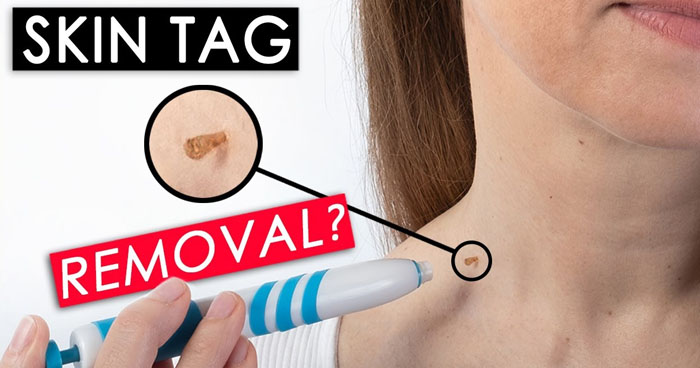Skin tags are soft, fleshy protrusions on the skin’s surface that sometimes hang off the skin. These harmless growths are not cancerous, but some people choose to have them removed for aesthetic reasons since they can sometimes be irritating because they can get snagged by jewelry or rub against clothing.
What Is A Skin Tag?
Acrochordons, often known as skin tags, are benign skin growths consisting of collagen fibers, nerve cells, fat cells, and skin-covering. They might be darker but are often flesh-colored. They frequently begin as a little, flat bump. While this is sometimes the case, more frequently they start to gradually protrude from the skin. Although they can develop almost anywhere, skin tags frequently do so in skin folds. The eyelids, neck, armpits, groin area, and under the breasts are all common sites.
Unlike picking off a scab or a pimple, skin tags have a little stem at the base that keeps them firmly in place (per Cleveland Clinic). Therefore, there are risks to be aware of if you’re thinking about removing a skin tag at home.
Why You Should Not Remove a Skin Tag At Home?
Removing Skin Tag at Home Can Lead to Bleeding, Infection, or Irritation
According to experts at Water’s Edge Dermatology, attempting to remove a skin tag with scissors or nail clippers increases the risk of infection and inflammation.
“At times, this can be done successfully with smaller skin tags and most people won’t have a problem,” said Dr. Ted Schiff, chief medical officer and founder of Water’s Edge Dermatology. “However, it’s often painful and takes a long time when it does work, and occasionally, we’ve seen people try to tie off something inappropriate or that is too big and it leads to an infection or skin irritation.”

Furthermore, skin tags can produce a significant amount of blood despite their modest size. Emergency care may be needed if there is severe bleeding.
If you think that tying a skin tag off with a piece of string sounds more enticing, you might want to reconsider. It takes significantly longer to do this, and doctors warn that as the skin tag slowly decays, you might experience a rotting smell. Overall, it hurts quite a bit when a skin tag is removed forcibly.
Never use any kind of home remedy to remove a skin tag on or near the eyelid or genitals.
You Can’t be Certain it’s Actually a Skin Tag
Rarely, a growth that you believe to be a skin tag could actually be something else entirely, such as a wart or a kind of skin cancer like melanoma. Therefore, it’s crucial to have a dermatologist examine a growth before deciding whether to have it removed. In the case that a skin cancerous growth is removed, cancer cells may remain behind and continue to grow and spread.
Additionally, a skin tag may occasionally be a symptom of a hormonal or endocrine syndrome such as polycystic ovarian syndrome or acromegaly (PCOS). The skin tag may be sent to a lab for additional testing if the dermatologist suspects an underlying disease.
To Conclude
Considering all of this, visiting a dermatologist is the best decision to make if a skin tag is irritating you or you simply don’t like the way it looks and wants it removed.
Leave skin tag removal to the professionals who can remove it through surgical means, cryotherapy, or cauterization. When a skin tag is removed properly by a dermatologist, it is unlikely to grow back (via AARP). However, if you are prone to skin tags, more may develop over time on the same parts of the body.



